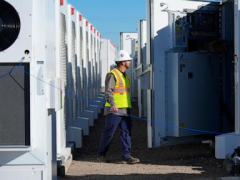2024 was another banner year for a source of electricity that is better for people’s lungs, better for climate change and may be reaching your home when you turn on the lights or turn up the thermostat — large banks of batteries.
This ability to store large amounts of electricity in batteries was essentially nonexistent a decade ago, but the country had about 24 gigawatt-hours operating as of the end of November, up a whopping 71% over the same date in 2023.
This is welcome news to clean energy advocates including Dariella Rodriguez. She has seen what happens on days when demand for air conditioning or heating spikes and extra power plants fueled by natural gas, located in Port Morris and Mott Haven, fire up not far from where she works in Hunts Point in the South Bronx, New York.
Batteries can jolt into service, sending electricity onto overhead wires, instead of these dirty “peaker” plants. Rodriguez hasn’t seen that transition yet, but she hopes to.
“The people that are exposed to these plants are the most vulnerable people in environmental justice communities already,” said Rodriguez, a director at THE POINT Community Development Corporation there, noting that lower-income people and communities of color often live near peakers.
The nation’s 1,000 peaker plants can be very dirty, inefficient and expensive, according to an analysis by the U.S. Government Accountability Office, a watchdog group that works for the U.S. Congress. Some 63 million people are estimated to live within a three-mile radius of one.
Although peakers run only a small part of the time, they release more harmful nitrogen oxides and sulfur dioxide per unit of energy, the agency said. Those two pollutants cause asthma and other breathing problems.
Peakers also release more greenhouse gases than other power plants do per unit of electricity.
Batteries are “a really obvious solution” to reducing need for peakers, says Daniel Chu, senior energy planner for the New York City Environmental Justice Alliance.
Storing extra power in batteries also extends the hours of the day that you can use clean energy.
“It’s not always sunny, the wind’s not always blowing, but energy storage can help move that generation to when it’s most needed,” said Tim Fox, managing director at research firm ClearView Energy Partners.
That’s why at least half of battery storage facilities in the U.S. are co-located with, or in some other way support solar, an AP analysis of Energy Information Administration data shows. The amount of solar energ



